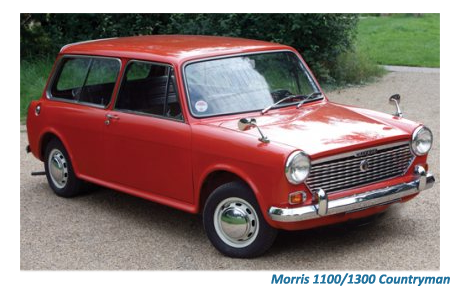
The Morris 1100/1300 series, in tandem with its stablemate and clone, the Austin 1100/1300 was one of BMC's major successes of the Sixties.
The Morris 1100 was the first of the combination to be launched in 1962, almost a year before the Austin went on sale.
 Apart from the badging, the only real difference from the Austin was in the fascia/instrument panel design.
Apart from the badging, the only real difference from the Austin was in the fascia/instrument panel design.
The Morris 1100 was released in September 1963, powered by a A40-sized A-Series engine with spur gear drive to the front wheels.
An extra power boost came from a single SU HS2 carburettor,meaning that the 1100's engine was capable of generating a respectable 48 bhp.
Once again, the already well-proven combination of Sir Alex Issigonis's innovative engineering, Farina styling, and simple yet pleasing overall design packaging geared to the rapidly emerging middle class in the UK was an almost certain winning formula.
 The entire BMC generated package covered no less than six BMC badges, taking in not only Morris but also Austins, MG, Riley. Wolseley and Van Den Plas.
The entire BMC generated package covered no less than six BMC badges, taking in not only Morris but also Austins, MG, Riley. Wolseley and Van Den Plas.
All of these models emanating from the BMC’s design studio at Longbridge in the Midlands of England.
Mechanically the 1100 bore a very strong resemblance to the renowned mechanical package used in the Mini, including the famous— transverse A-Series engine with gearbox and front-wheel-drive combination.
The 1100 sat comfortably in a niche of its own within the BMC family, more spacious, more elegant and more comfortably appointed than both the Mini and the Morris 1000, but also handled well and well priced.
By no coincidence the Morris 1100 and 1300 models carried exactly the same price ticket as the Austin when it was launched a few months later.
![]()
The Morris 1100 were offered as either two- and four-door versions, while a De Luxe version was also available, featuring twin horns, stainless steel window frames among several other minor upgrades of a similar ilk.
 Optional AP automatic transmission came in 1965, the Countryman estate car followed in March with an opening tailgate and providing first-class interior accommodation for such a small overall package.
Optional AP automatic transmission came in 1965, the Countryman estate car followed in March with an opening tailgate and providing first-class interior accommodation for such a small overall package.
In May 1966 reclining front seats became an attractive optional extra, and the Mark Is continued basically unchanged until October 1967, when the new Mark II models were introduced in De Luxe, Super de Luxe two-door and four-door and Countryman versions.
 These versions had a similarly restyled grille surround to the Mark II Minis, with repeater indicators standard on the front wings, cut-back tail fins with larger rear lights (apart from on the Countryman) and with the new 'Mk II' emblem on the tail.
These versions had a similarly restyled grille surround to the Mark II Minis, with repeater indicators standard on the front wings, cut-back tail fins with larger rear lights (apart from on the Countryman) and with the new 'Mk II' emblem on the tail.
The central instrument panel was finished in wood with a circular speedometer replacing the previous ribbon type and tumbler switches being standardised.
The 1100/ 1300's upholstery was restyled and improved while the Super de Luxe and Countryman models were alse embellished with additional chrome on the window surrounds and a full-width fascia in a silver finish.
The only possible" fly in the ointment" in the 1100's overall cabin design was that themodel still came fitted with an old-fashionedstrip speedometer that often went round the clock, making it impossible to register an accurate mileage.
![]()
To add to its " rural image," the Morris 1100 Countryman also came with a simulated wood side stripe.
While the standard 1100 engine fitted in the Morris could reach a top just under 80 mph (128 k/ph) and could get from 0-50 mph in under 15 sec, to many this was not a sufficient performance level, even though the car averaged around 35 mpg( 17 k/pl).
 To meet the expectations of those who were prepared to forsake fuel economy for improved performance, late in 1967 BMC released the Morris 1300 powered by a low-compression version of the 1275-cc Cooper engine, generating 58 bhp net at 5,250 rpm.
To meet the expectations of those who were prepared to forsake fuel economy for improved performance, late in 1967 BMC released the Morris 1300 powered by a low-compression version of the 1275-cc Cooper engine, generating 58 bhp net at 5,250 rpm.
In comparison with the 1100's performance figures, the 1300's maximum speed was raised to about 88 mph, 0-50 mph acceleration.
The Morris 1100 and 1300s were, without a doubt, BMC's star models of the Sixties selling more than a 1.1 million units.
An indication of BMC's rapidly defining fortunes came in 1974 when the model was eventually discontinued after more than ten years in production, to be replaced by the catastrophic Allegro.






